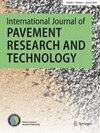Multi-time Step Deterioration Prediction of Freeways Using Linear Regression and Machine Learning Approaches: A Case Study
IF 2.5
Q2 CONSTRUCTION & BUILDING TECHNOLOGY
International Journal of Pavement Research and Technology
Pub Date : 2023-09-19
DOI:10.1007/s42947-023-00376-x
引用次数: 0
Abstract
Abstract Multi-time step deterioration prediction of road pavements can provide more options for effective maintenance and rehabilitation decision under limited resources as compared to single time step prediction. This paper presents the 1–4 time step ahead prediction of the pavement cracking, rutting and roughness using their past values together with climate and traffic data as model inputs. Three prediction models were adopted, including the simple multiple linear regression (MLR) model and two sophisticated machine learning models, namely, support vector regression (SVR) and genetic programming (GP) models. An industry dataset of spray seal freeways is used to demonstrate the application of the methodology developed in this study. After calibration with observed data, the three prediction models are tested with unseen datasets using three performance indicators, namely, mean squared error (MSE), mean absolute percentage error (MAPE) and coefficient of determination (R squared). Among many results, all three models are unable to predict cracking with acceptable prediction accuracy. On the other hand, the rutting and roughness can be predicted with relatively good accuracy up to 4 time steps ahead. The sensitivity analysis shows that roughness and rutting prediction depends significantly on their previous or lagged values and not on remaining inputs such as annual average daily traffic (AADT) and rainfall. The methodology developed in this study is also applied to another dataset of asphalt freeways, which have similar model inputs. Similar findings are found with this dataset of asphalt freeways to that of spray seal freeways. The simple MLR model can produce similar prediction performance to the sophisticated SVR and GP models for rutting and roughness, suggesting the use of the MLR model as a benchmark for any development of prediction models for pavement deterioration.基于线性回归和机器学习方法的高速公路多时间步长退化预测:一个案例研究
与单时间步长预测相比,多时间步长路面劣化预测能为有限资源下的有效维修修复决策提供更多选择。本文利用路面裂缝、车辙和粗糙度的过去值以及气候和交通数据作为模型输入,提前1-4个时间步预测路面裂缝、车辙和粗糙度。采用了简单多元线性回归(MLR)模型和支持向量回归(SVR)和遗传规划(GP)两种复杂的机器学习模型三种预测模型。喷雾密封高速公路的行业数据集用于演示本研究中开发的方法的应用。在对观测数据进行校正后,使用均方误差(MSE)、平均绝对百分比误差(MAPE)和决定系数(R平方)三个性能指标对三种预测模型进行检验。在众多的结果中,这三种模型都不能以可接受的预测精度预测开裂。另一方面,车辙和粗糙度可以提前4个时间步长以较好的精度预测。敏感性分析表明,粗糙度和车辙预测主要依赖于它们的前值或滞后值,而不依赖于年平均日交通量(AADT)和降雨量等剩余输入。本研究中开发的方法也适用于具有类似模型输入的另一个沥青高速公路数据集。沥青高速公路的数据集与喷雾密封高速公路的数据集发现了类似的结果。简单的MLR模型对车辙和粗糙度的预测效果与复杂的SVR和GP模型相似,建议将MLR模型作为任何路面劣化预测模型开发的基准。
本文章由计算机程序翻译,如有差异,请以英文原文为准。
求助全文
约1分钟内获得全文
求助全文
来源期刊

International Journal of Pavement Research and Technology
Engineering-Civil and Structural Engineering
CiteScore
4.90
自引率
0.00%
发文量
120
期刊介绍:
The objective of the International Journal of Pavement Research and Technology is to provide a platform to promote exchange of ideas among pavement engineering communities around the world. The journal attempts to disseminate information on all aspects of pavement engineering and technology developed through research and practical experiences.The journal is published bi-monthly, in January, March, May, July, September, and November each year (six issues in each volume). Contributions in the form of research paper, review, or discussions will be considered for publication. To cover a wide range of pavement engineering disciplines and industrial applications, the journal includes the following topics:
Advanced analytical and computational techniques in pavement engineeringPavement mechanics and pavement designPavement construction, performance, management, maintenance, and rehabilitation techniquesPavement materialsPavement recyclingPavement surface and subsurface drainageEnvironmental issues associated with pavement materials and constructionAccelerated and full-scale pavement testingNon-destructive testingInnovative design method and practicePavement-vehicle interaction and safety issuePavement PreservationPavement Instrumentation
 求助内容:
求助内容: 应助结果提醒方式:
应助结果提醒方式:


